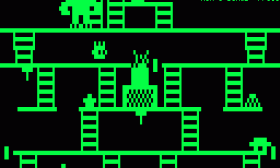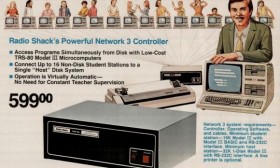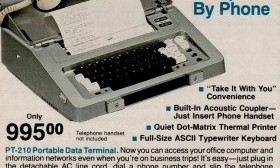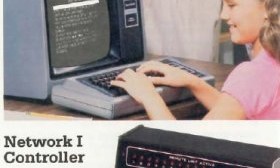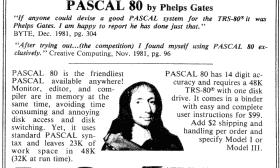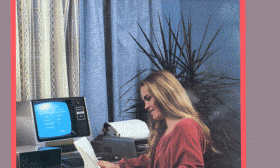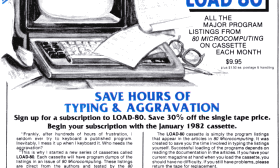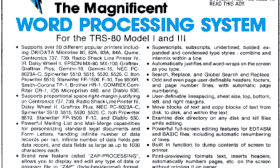Wayne Westmoreland and Terry Gilman wrote some of the best games for the TRS-80 Model I and III, including classics such as Sea Dragon and The Eliminator. When Wayne Westmoreland released all of their games to the public domain in 1995, TRS-80 owners received an unexpected treat: Donkey Kong, a previously unreleased TRS-80 game.
Donkey Kong was based on the Nintendo arcade game of the same name from 1981. The hero of the Nintendo game is a carpenter named Mario (who later became better known in the game Mario Bros). The goal is to rescue Mario’s girlfriend Pauline from the marauding Donkey Kong. Mario needs to reach Pauline at the top of the screen, all the while dodging barrels thrown by Donkey Kong. Other obstacles include conveyor belts, elevators, and fireballs.
(Read more...)
The Radio Shack Network 3 Controller (catalog number 26-1212) was a networking system designed for use in classrooms. First appearing in the 1983 catalog, the Network 3 Controller cost $599.00. Unlike the earlier Network I> and Network 2 Controllers, which worked with more than one type of TRS-80 computer, the Network 3 Controller only supported the Model III or Model 4 in Model III mode.
From the description in a 1983 Radio Shack catalog:
The Network 3 Controller enables up to 16 Model III student stations to choose from lessons stored on a teacher’s “host” system. This frees the instructor from repeatedly loading programs into individual stations. And scores are automatically stored on the host disk for later review as lessons that generate student record keeping are completed. The Network 3 also allows computer science students to learn Disk BASIC on a non-disk Model III. That means you get the features of a disk-equipped computer, but at about half the price!
(Read more...)
The TRS-80 PT-210 Portable Terminal (catalog number 76-1001) was a mobile dumb terminal that provided a way for travelers to access remote computers while on the road. Introduced by Radio Shack in late 1982 for a price of $995.00, the PT-210 was promoted with the slogan “Now there’s a TRS-80 you can take with you on business trips!”"
The PT-210 weighed 15 pounds and came in a briefcase-style case. It contained a full-size 53-key keyboard, an acoustic coupler that communicated at 110 or 300 baud, and a “whisper-quiet” thermal printer. The catalog description stated:
(Read more...)
The Radio Shack Network I Controller (catalog number 26-1210) was an early networking system for the TRS-80. Introduced on March 1, 1980, the Network I Controller (originally called the TRS-80 Model I Network I) cost $499.00 and was primarily designed for classroom use.
The Network I concept, described as “teacher-centric,” was based around a disk-based Model I (used by a teacher) connected through a Network I Controller and cassette cables to cassette-based Model I’s (used by students). Up to sixteen student computers could be connected over a distance of up to thirty feet. From the announcement in the TRS-80 Microcomputer News:
(Read more...)
The TRS-80 Model 4, introduced in 1983, was 100% software compatible with its predecessor, the TRS-80 Model III. A cassette-based Model 4 behaved identically to a cassette-based Model III and could run all Model III software. But a disk-based Model 4 could also run new Model 4 software that exposed features unique to the Model 4, such as extra memory and a larger text resolution. For Model III owners who wanted to run the new software but were unwilling to discard their Model III, Radio Shack offered the Model III to 4 Upgrade Kit.
The Model III to 4 Upgrade Kit (catalog number 26-1123) originally cost $799.95 and was introduced at the same time as the Model 4. It could convert a disk-based Model III into a disk-based Model 4, capable of running all Model 4 programs. One early Model 4 advertisement stated that “Model III disk system owners can get all the new Model 4 features by adding our upgrade kit.”
The Model III to 4 Upgrade Kit consisted of several parts:
(Read more...)
Pascal 80 was a Pascal development system for the TRS-80 Model I, III, and 4. It was written by Phelps Gates, also the author of APL-80, an APL compiler for the TRS-80.
The Pascal 80 package consisted of a full-screen text editor, monitor, and compiler. Pascal source code could be compiled directly to memory or to disk. Editing and compiling Pascal source code in memory made programming Pascal similar to using interpreted languages, such as BASIC. According to the Pascal 80 manual:
Efficient and compact code allows Pascal 80 to have a monitor, editor, and compiler in the computer at the same time, yet leave enough room to create programs up to 23K bytes, with an additional 9K available while the program is running for variables and work space. This allows programs to be written, compiler, edited, and compiled again without time consuming disk access.
When written to disk, resulting programs could either be created as p-code (an intermediate compiled format) or could be merged into standalone /CMD files.
(Read more...)
80 Microcomputing, also known as 80 Micro, was the most famous of the TRS-80 magazines and the best remembered. It was the first of the platform-specific computer magazines to become very popular, creating a model that many other magazines followed. Harry McCracken, former editor-in-chief of PC World, described PC World as “essentially an 80 Micro clone that happened to be about Windows, not TRS-80’s.”
80 Microcomputing published for 101 issues from January 1980 to June 1988, plus one special anniversary issue in 1983. With the combined June/July 1982 issue, 80 Microcomputing was renamed to 80 Micro and the cover date was advanced one month.
The magazine was very successful and spawned:
(Read more...)
Like most early microcomputer magazines, 80 Microcomputing published many reader submitted programs. These programs were among the most popular features of the magazine but needed to be typed into a computer before they could be used. Typing in long program listings was time consuming and there was always the real possibility of introducing errors during the typing process.
Selling a tape containing the programs from 80 Microcomputing was an idea mentioned almost from the beginning of the magazine. That idea eventually led to the product named LOAD-80. Wayne Green, the publisher of 80 Microcomputing, first referred to LOAD-80 in his “80 Remarks” column in the April 1981 issue:
(Read more...)
Computer software has always used version numbers, but there have been many different ways of managing them. (For an interesting history of version numbers, see the article The Amazing World of Version Numbers by Harry McCracken.)
Most personal computer software followed a consistent pattern of major and minor version numbers. I found this description of the Radio Shack approach to version numbering from the TRSDOS and DISK BASIC Reference Manual to be interesting:
(Read more...)
Zorlof the Magnificent was a powerful word processor for the TRS-80 Model I and III. It was written by Peter Ray and sold by Anitek Software Products of Melbourne, Florida. Released in 1982 for a price of $69.95, Zorlof was often described as a “second-generation word processor,” one generation beyond Electric Pencil and Scripsit.
Zorlof was a full-screen word processor that supported lowercase on the Model I. It provided 61 editing functions, which included common tasks such as deleting lines, global search and replace, and block moves. Word-wrapping and justification were automatically handled by Zorlof. As it stated in the manual:
(Read more...)
